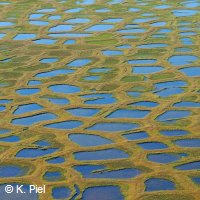Study sheds light on period of climate change 40,000 years ago
EU-funded scientists have determined the source of methane that triggered a period of rapid global warming 40,000 years ago. Writing in the journal Science, they explain that the gas came from northern wetlands and not, as many believed, from ocean sediments. EU support for the work came from the EUR 2.1 million, 5-year MATRICS ('Modern approaches to temperature reconstructions in polar ice cores') project, which is funded through an Advanced Grant from the European Research Council (ERC) to Professor Hubertus Fischer of the University of Bern in Switzerland. The last glacial period was punctuated by around 25 episodes of rapid warming called Dansgaard-Oeschger events that happened every few hundred years and lasted for decades at a time. Studies of ice cores revealed that Dansgaard-Oeschger events coincided with periods when atmospheric methane levels were relatively high. Scientists have long debated the source of this methane. According to one popular theory known as the 'clathrate gun hypothesis', the gas entered the atmosphere when rising ocean temperatures along the continental margins triggered the release of methane that had been stored as clathrate in the seafloor. Meanwhile, other researchers argued that the gas came from northern wetlands. Questions have also been raised as to whether the rising temperatures triggered the release of methane or vice-versa, as methane is a powerful greenhouse gas. To get to the bottom of the matter, the scientists from Denmark, Germany and Switzerland studied methane from air bubbles trapped in ice cores taken from the Greenland ice sheet. These bubbles offer a snapshot of the composition of the atmosphere in the distant past. In this study, the team focused on ice core samples dating from between 33,700 and 41,000 years ago, a period that spans two Dansgaard-Oeschger events. The team exploited the fact that some methane molecules have a couple of extra neutrons and so are a little heavier than normal. Crucially, methane from wetlands has fewer of these 'heavy' methane molecules than methane produced in the ocean. The analysis revealed that the methane was released from wetlands in high northern latitudes in response to the warming. The scientists are keen to underline that the period of dramatic climate change 40,000 years ago cannot be compared to what is going on today. 'Our results do not imply that methane or other greenhouse gases play no role for climate change. Our study reflects natural climate conditions during the last ice age, long before mankind affected global climate by emitting greenhouse gases,' they state. 'At that time climate warming caused an increase in methane concentration, generating in turn a more substantial greenhouse effect. Nowadays, additional methane and carbon dioxide are artificially emitted into the atmosphere by human activities and are the main driver of the observed climate warming.'
Countries
Switzerland, Germany, Denmark



